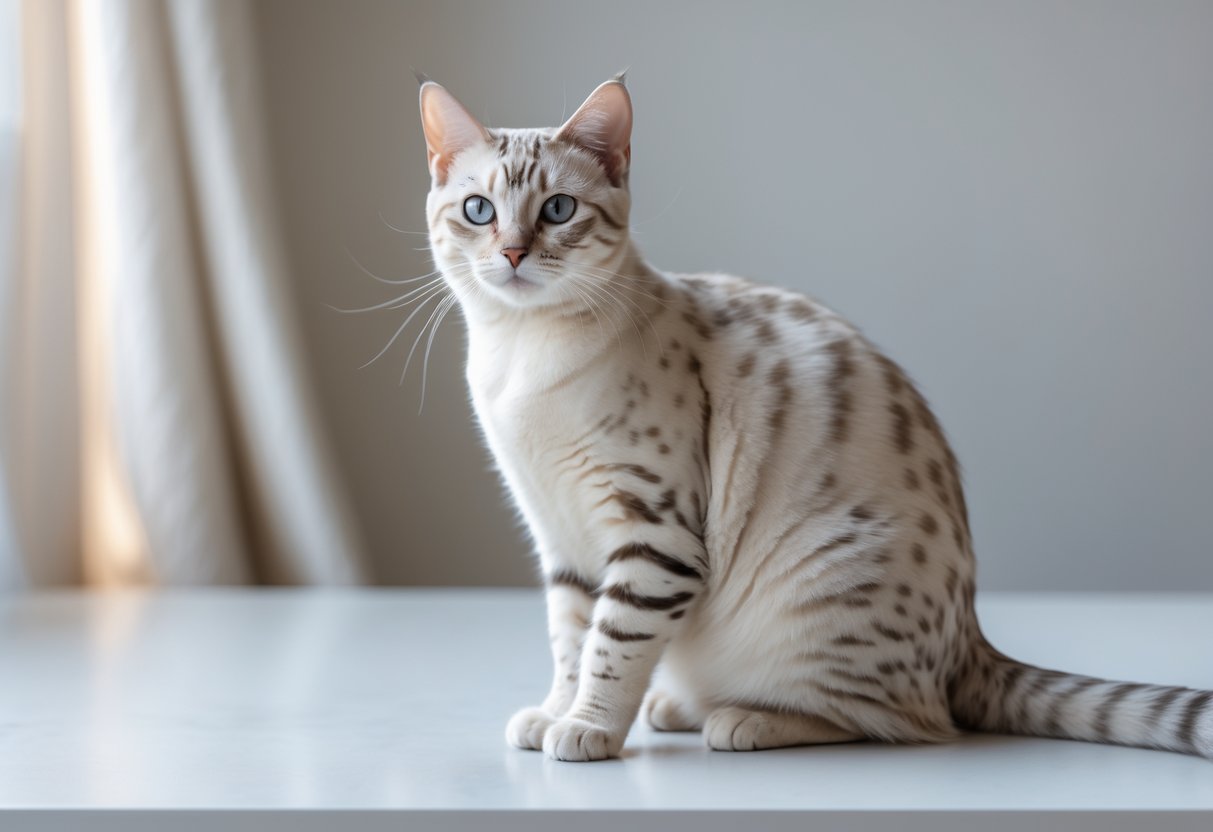Snow Bengal Cat Care Guide: Essential Tips for Health and Happiness

The Snow Bengal cat is a unique and striking variation of the Bengal breed, known for its light-colored coat and wildcat appearance. It combines the playful, smart personality of Bengal cats with a rare and beautiful pale coat that stands out among domestic cats.
These cats are medium to large in size and are known for being energetic, intelligent, and sociable. They require attention and care, making them a good fit for owners who can provide time and interaction. Their behavior and traits make them more than just pets, they are loyal companions who can learn tricks and even enjoy walking on a leash.
Snow Bengals come in different types, such as Mink or Sepia, which affect their coat color and eye shade. They are generally healthy, low shedding, and can even be hypoallergenic, appealing to people looking for an active, affectionate, and visually stunning cat.
Snow Bengal Cat Overview

The Snow Bengal cat is known for its unique coat and an active personality. Its origins and breed standards highlight its distinct traits and set it apart within the Bengal breed.
History and Origins
The Snow Bengal cat comes from crossing an Asian leopard cat with domestic cats like the Siamese or Burmese. This mix created a breed with a wild look but a friendly nature. The snow coloring developed over time through selective breeding focused on lighter coat colors.
Its coat features very light cream or white backgrounds with soft, muted markings. This color pattern is different from the traditional spotted or marbled Bengals. The breed is still closely tied to the original Bengal line but stands out due to its unique coat genetics.
Recognition and Standards
Snow Bengals are recognized by many cat associations but sometimes under the broader Bengal category. The key identifiers include a pale cream or white background with either dark or light seal-colored markings.
They always have blue eyes and often a dark brown or seal-colored tail tip. These features are important in breed standards and help maintain the Snow Bengal’s distinct appearance.
| Feature | Description |
|---|---|
| Coat Color | Very light cream or white |
| Markings | Dark or light seal patterns |
| Eye Color | Blue |
| Tail Tip | Dark seal brown |
These traits define the Snow Bengal and separate it from other Bengals.
Physical Characteristics

The Snow Bengal Cat stands out with a sleek, muscular build and a coat that changes as it grows. Its eyes and body shape reflect both wild ancestors and domestic traits. These cats have clear features that set them apart from other Bengal types.
Coat Patterns and Colors
Snow Bengals have unique coat colors that start pure white at birth. As they mature, markings develop that are usually lighter than other Bengals. Common patterns include spots and marbled lines in shades like seal lynx point, mink, or sepia.
Their fur is short to medium in length, soft, and dense. The coat feels thick and silky, similar to a pelt. The pattern arrangement is random or follows horizontal lines. This combination creates a striking look that blends wild style with domestic softness.
Eye Colors and Features
Snow Bengals often have bright, large eyes that stand out on their light-colored faces. Eye colors range from blue to green, and sometimes eyes show a mix of colors. This diversity in eye color ties to their Siamese heritage.
Their eyes are almond-shaped and expressive. The clear contrast between eye color and fur helps highlight their gaze. This feature adds to their alert and intelligent appearance.
Size and Build
Snow Bengals are medium to large cats with a sturdy build. Males usually weigh between 10 to 20 pounds, and females from 8 to 15 pounds. Some can grow heavier but rarely exceed 25 pounds.
Their bodies are longer and leaner than typical house cats. They have muscular backs and hind legs that are longer than front legs. This build helps them move quickly and with agility. Their paws are large and round, while their tails are longer than average cats’.
Temperament and Personality

The Snow Bengal cat is known for its intelligence and energy. It shows curiosity and often seeks attention from its owners. This breed combines an active nature with a friendly disposition.
Behavioral Traits
Snow Bengals are very energetic and playful. They enjoy climbing and exploring their space. Their intelligence means they can learn tricks or respond to training with patience.
They are often vocal and use sounds to communicate their needs. Because of their high energy, they need regular playtime to avoid boredom. Without enough activity, they may become restless or destructive.
These cats are also smart problem solvers. They tend to open doors or find hidden toys. Owners should offer puzzle toys or interactive games to keep them mentally active.
Interaction With Children and Pets
Snow Bengals usually get along well with children. Their playful nature matches active kids, making for good companionship. However, supervision is important to prevent rough handling, as the cat might become stressed.
They can live peacefully with other pets if introduced properly. Their social personality helps them adapt to dogs or other cats. Early socialization improves these relationships.
Like all cats, individual temperament varies. Some Snow Bengals might be more reserved around pets or children, while others are very outgoing and affectionate.
Health and Lifespan

The Snow Bengal cat needs proper care to stay healthy and live a long life. Paying attention to their common health problems, diet, and overall wellbeing is important for any owner.
Common Health Issues
Snow Bengals are prone to some health issues seen in other cat breeds. One of the main concerns is Hypertrophic Cardiomyopathy (HCM), a heart disease that affects the heart muscle. Regular vet check-ups can help catch this early.
Obesity is another common problem, often caused by lack of exercise or overfeeding. Excess weight can lead to other complications like joint stress.
Other issues include dental problems and potential sensitivity to certain foods. Maintaining a clean diet and monitoring their weight supports their long-term health.
Nutrition and Dietary Needs
Snow Bengals require a balanced diet high in protein to support their active nature. Many need more food compared to other cat breeds because of their muscle mass.
Feeding should focus on quality wet and dry food formulated for medium to large cats. Avoid overfeeding to prevent obesity.
Fresh water should be available at all times. They benefit from regular feeding schedules and portion control to maintain a healthy weight.
Life Expectancy
Snow Bengals generally live between 12 and 16 years. With excellent care, some can reach 18 years or more.
Their lifespan depends on genetics, diet, exercise, and veterinary care. Owners should provide regular medical check-ups and maintain a healthy environment.
Proper nutrition and preventing health issues support a longer, healthier life for the Snow Bengal.
Best Dry Dog Food Options For Snow Bengal Cat

Snow Bengal cats need dry food that supports their active lifestyle. Their diet should be high in protein and fat to help maintain energy and muscle strength. Choosing top-quality dry food is key to keeping them healthy.
Royal Canin Bengal Adult Dry Cat Food is a popular choice because it is made specifically for Bengals. It offers the right balance of nutrients, including protein and fat, to support their unique needs.
Another good option is Acana Grain Free Wild Prairie Adult Dry Cat Food. It uses natural ingredients with no grains, which some owners find helps with digestion and overall health. Many Snow Bengals enjoy its taste.
Nulo Dry Cat Food is praised for its slow-dried raw ingredients. It meets high nutritional standards and is known to be a balanced choice for Bengals. This brand often receives special certifications for quality.
When feeding dry food, it is important to monitor water intake. Dry food has low moisture, so cats might not get enough water. Owners should always provide fresh water to prevent dehydration and kidney issues.
Some key points to consider:
- High protein content
- Grain-free or low-grain options
- Balanced fat levels
- Quality ingredients
These factors help support the Snow Bengal’s energy, muscle tone, and overall health.
Care and Grooming

Snow Bengal cats need regular care to stay healthy and happy. Their grooming is simple but must be done carefully. They also require lots of physical and mental activity to prevent boredom.
Grooming Requirements
Snow Bengal cats have short to medium fur that is soft and dense. They need weekly brushing with a soft-bristled brush to remove loose hair and reduce shedding. This also helps prevent hairballs.
Bathing is rarely needed unless the cat gets very dirty. Regular nail trimming and ear cleaning are also important.
Dental care should include brushing their teeth or providing dental treats to maintain oral health.
A clean litter box and a healthy diet support their overall hygiene and wellbeing.
Exercise and Enrichment
These cats are active and curious. They need daily playtime to use their energy and stay fit.
Interactive toys like feather wands, laser pointers, and puzzle feeders work well with them. Climbing shelves and cat trees offer good physical challenges.
Mental stimulation is also key. Training sessions, hiding treats, or rotating toys keep Snow Bengals engaged.
Providing consistent exercise prevents behavior problems linked to boredom and helps maintain a healthy weight.
Finding and Adopting a Snow Bengal Cat

Finding a Snow Bengal cat requires careful research and planning. It is important to look for ethical breeders and understand the responsibilities of adopting this active and unique breed.
Selecting a Responsible Breeder
A responsible breeder focuses on health, temperament, and proper care of Snow Bengals. They screen cats for genetic diseases and provide health clearances. This protects the kittens from common health issues.
Good breeders show transparency. They allow visits to their cattery and answer questions about the cat’s lineage and care. They also support new owners with advice after adoption.
Prices can vary, but a higher fee often reflects better care and medical checks. Breeders usually require an adoption contract to ensure the cat’s well-being in its new home.
Adoption Considerations
Adopting a Snow Bengal means preparing for an active and intelligent cat. They need space to climb and play to stay healthy and happy.
Owners should consider the cat’s social needs. Snow Bengals tend to bond closely with their people and may not like long periods alone.
Veterinary care, diet, and grooming are also important. Snow Bengals have short coats but need regular care to avoid skin problems. Budgeting for these expenses is crucial before adoption.

Frequently Asked Questions
Snow Bengal cats are known for their lively behavior, distinctive looks, and specific care needs. They vary in size and price and may be less common than other Bengal variations. Potential owners should consider these factors carefully before adoption.
